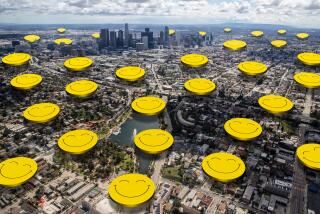FOCUS: Orange County Focus is dedicated on Monday to analysis of community news, a look at whatâs ahead and the voices of local people. : An Artist Reminisces About the Changing Landscape : IN PERSON
LAGUNA BEACH â Ask Armen Gasparian anything, but not about his art.
Gasparian, a noted local landscape and figurative artist whose bold, colorful oils are immensely popular here, canât bear to talk about his work.
âI hate talking shop, Iâm not sure exactly why,â said the ever dapper Gasparian, 61, who always wears a chapeau, several daysâ growth of gray beard and a grin. âItâs a romantic idea I guess that artists get together and philosophize and talk about art and life. But I donât. I feel so pompous talking like that.â
Gasparian is one of the fortunate ones who came to Laguna Beach from Los Angeles as a young man and, following in the footsteps of the early California plein-air artists of the early 1900s, managed to make a grand living painting the enchanting Mediterranean-style landscapes of its canyons and coastline.
Now he lives nearly full time in Paris but still manages to come to Laguna Beach at least once a year to visit the beach community where he made his name. Laguna Beach, now thatâs something he can talk about for hours.
âThereâs something about the geography here that attracts painters, the way the hills come down to the coast, the clarity of light,â Gasparian said.
*
Those elements will always be here, Gasparian notes. But the opportunities for young artists to become successful in Laguna Beach as he did, always considered a long shot, are even more difficult now, Gasparian said.
In his day, the late 1960s, a large, high-ceilinged Coast Highway studio could be rented reasonably and a cheap Laguna Beach apartment could be found easily, complete with inspirational white water views.
Gasparian shared a studio with Frank Interlandi on the highway between the Pottery Shack and the Sound Spectrum, two still-thriving Laguna landmarks. Today, like most Coast Highway frontage, rents have skyrocketed and Gasparian--let alone a young artist--would be hard-pressed to afford it.
âIt was a delightful time to be in Laguna. I still consider it one of my most creative periods. I donât have that kind of space now in Paris and I miss it. But Laguna Beach was still remote then, more low rent, maybe it was more carefree,â Gasparian said. âArtists arriving in Laguna today donât have the same opportunities and privileges we had. As every place moves on, it takes on a different perspective, a different atmosphere. Of course, there are other things to offer now it didnât have then.â
Gasparian can see similar changes creeping into his new Paris neighborhood near La Place de la Bastille, on the border of the Marais-Bastille area of the cityâs fourth arrondissement. An old artistsâ village, its charm is beginning to attract a higher-rent clientele, which could spell disaster for those of lesser means, he said.
âIt is still an old artist area with lots of studios, at the crossroads of the two districts, but itâs changing, unfortunately, losing the small shops, the button makers and the knife sharpeners,â he said. âThe fancy boutiques are moving in. The Marais and the Bastille are becoming more expensive. Itâs the same as in Laguna.â
But Gasparian is not one who suggests that the Laguna Beach City Council should step in and help provide studio space. That sort of manipulation does not fit his laissez faire attitude, he said.
âYou canât legislate art,â he said. âArtists have universally discovered places where it was comfortable and stimulating for them to work. In time, these places change for whatever reason and artists go to other places. The only thing a city can do is support the arts, like Laguna did when it started the Festivalâ of Arts.
Gasparian, who taught at the old Laguna Beach School of Art for 15 years, was also a longtime exhibitor at the Festival of Arts, starting back when it was the only festival in town. In 1984, the festival organizers chose one of his paintings from what he calls his âair seriesâ for its first-ever poster.
*
Gasparian does most of his work in bunches, what he calls a âseries.â For the âair series,â he hired a pilot with a small plane and they flew up and down the cityâs coast, searching for a new perspective.
âLaguna is a subject with endless possibilities to paint. Iâm basically what they call an easel painter. . . . I wanted to do something different, to look at the coast from above and from the ocean looking in,â he said.
Gasparian no longer works when he stays in Laguna. Instead, he comes to see friends and, in their minds, the past is regained.
Heâll gather with the Interlandi brothers and Vincent Farrell and theyâll drink and talk and laugh and smoke their cigars and pretend, for a while, that it really is 1969 again.
âWe meet and try to act youthful,â he said, âwhich none of us is anymore.â
Instead of his old gathering haunt--the White House--he now meets his friends at the Hotel Laguna or the Saloon or Javierâs, places that allow them to smoke their cherished cigars.
âI still consider Laguna home, but I miss the camaraderie we shared,â he said. âOf course, we have all gotten old, some have died. But this is still such a small town. Itâs hard to go out anywhere without recognizing so many faces.â
More to Read
Sign up for Essential California
The most important California stories and recommendations in your inbox every morning.
You may occasionally receive promotional content from the Los Angeles Times.










